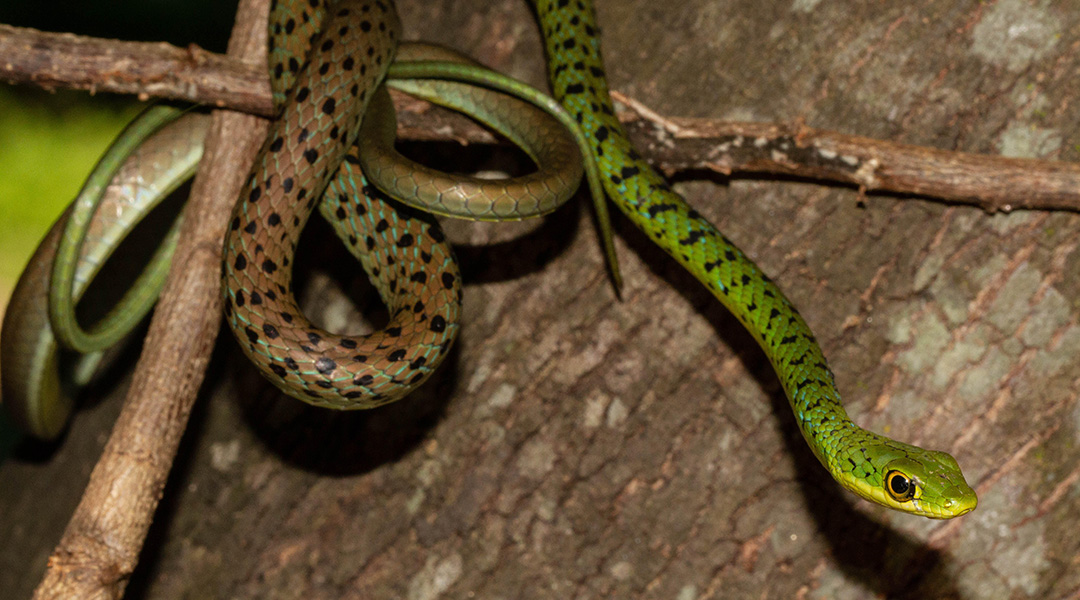Fear of snakes, no matter the species, leads many people to kill them on sight without knowing if they actually pose any danger. In Africa, snake bites cause over 20,000–32,000 deaths each year, and with the region’s population expected to double by 2050, snakes are expected to come under increasing pressure .
Harith Farooq, a postdoctoral researcher at Center for Macroecology, Evolution and Climate (CMEC) at University of Copenhagen in Denmark, is worried about how increased encounters and humans’ perception of snakes will affect conservation efforts.
“With over 10 years of experience working with snakes, I often receive photos of killed snakes from Mozambique for identification,” he said. “Additionally, in many Facebook groups dedicated to African reptiles, there are regular postings of requests for IDs for dead snakes — therefore killed without knowledge of their species or level of danger.”
Whereas in Europe, North America, and parts of Asia the number of people is stable or even decreasing, populations in Africa are the world’s fastest growing. Working with Jonas Geldmann, an assistant professor CMEC at the University of Copenhagen, Farooq used computer modeling to predict how changing human settlement patterns might affect human–snake encounters, perhaps putting more snakes at risk.
“As human settlements expand and intensify, areas that were once pristine or sparsely populated will experience more human activity, leading to more snakes being killed,” said Farooq.
In a previous study carried out in northern Mozambique, Farooq investigated how people’s fear of snakes affected their encounters. “Through over 1000 interviews with local communities, we found that snakes were frequently killed in various settings — homes, villages, and even in their natural habitats — unlike other reptiles and amphibians, which were generally ignored,” Farooq said.
Morgan Hauptfleisch, an associate professor of nature conservation at Namibia University of Science and Technology who was not involved in this study, commented that snakes are often overlooked in conservation efforts. “This is in contrast with charismatic mammals, such as cheetahs and elephants, which are in some cases far less threatened but are the focus of government and non-governmental conservation efforts,” said Hauptfleisch.
Farooq and Geldmann used human population growth estimates from three previously published scenarios: sustainable development, in which resource consumption decreases slightly; middle of the road, in which historical trends in resource consumption stay constant; and regional rivalry, in which resource consumption increases.
Using these predictions, they mapped human settlements, using a threshold of ten or more people per square kilometer, onto the ranges of the 754 snake species in Africa. Snake species were put into two groups according to their IUCN classification: not threatened (“least concern”) or threatened at any level.
Under the sustainable development scenario, they predicted decreased human–snake contact, but under the other two scenarios, they predicted substantially more. Under the more realistic regional rivalry scenario, by 2050 approximately 71% of the ranges of threatened snakes are expected to overlap with human settlements, a 22% increase from 2020. As well, the number of snakes categorized as “least concern” living in areas with high human density is expected to more than double.
“This could result in a significant increase in the number of snake species becoming threatened over the next few decades,” said Farooq. “Our assumption is that snakes constitute one of the most sensitive species to human expansion because they tend to be exterminated on sight.”
Farooq and Geldmann hope that these results will bring increasing conservation attention to these important but overlooked creatures. They would be in favor of the creation of policies that promote education about snakes, alleviating people’s fears and explaining the many ecosystem services provided by snakes, such as rodent control, which might encourage people to support snake conservation.
They hope, too, that snakes will be included in more conservation management plans to help them thrive in the face of human expansion.
Reference: Harith Farooq, Jonas Geldmann, The fear factor—Snakes in Africa might be at an alarming extinction risk, Conservation Letters (2023). DOI: 10.1111/conl.12998
Feature image: A Spotted Bush Snake (Philothamnus semivariegatus) photographed in Gorongosa National Park, Mozambique. One of the hundreds of harmless snakes that occur in Africa that are killed indiscriminately. Photo credit: Harith Farooq

















